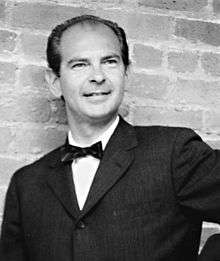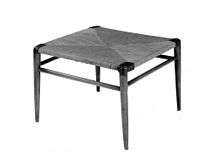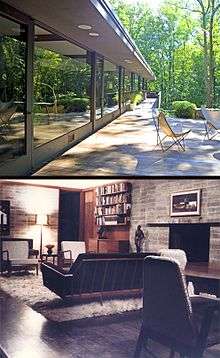Mel Smilow
Mel Smilow (March 5, 1922 – December 26, 2002) was an American furniture designer, artist, and partner in Smilow-Thielle, a mid-twentieth-century firm producing affordable, modern furniture[1] and other interior furnishings, with retail outlets located in the greater metropolitan New York area and Washington, DC.

Early years
Mel Smilow was born in the Bronx, New York, the son of Irving Smilowitz and Claire Benes. He attended New York City public schools and enrolled at the Pratt Institute in 1939 with the intent of becoming a commercial artist. As a result of his father's death that year, he was forced to withdraw and go to work as the family's only breadwinner: at 17, he took over his father's position selling wholesale furniture to retail stores in New York and Pennsylvania. Growing up during the years of the Great Depression and experiencing the discrimination against Jews that pervaded American culture at the time had a lasting influence on Smilow's art and world view. As a result, he was especially sensitive to the plight of the working class and the poor, and throughout his life championed causes that sought to end social inequality and discrimination in any form. He was proud that his employees were union members, and he consistently incorporated the qualities of great design with affordability and durability in his furniture.[2]
Military service
In 1944, Smilow enlisted in the army and after basic training was shipped to Europe, seeing action as an infantryman in the waning days of the war. Arriving in the French port of Le Havre, he travelled by train for two days in a box car until arriving in the Belgian town of Malmedy, where he witnessed the aftermath of the infamous Malmedy massacre and the carnage of the Battle of the Bulge, in the mountainous Ardennes region. Fighting in General Patton's Third Army during the grueling winter of 1944–1945, he was later awarded several medals including the Purple Heart for valor.
Career
After an honorable discharge from the army, Smilow returned to his job selling furniture. In 1949, in partnership with a colleague, Morton Thielle, he founded Smilow-Thielle, a manufacturer and retailer of modern furnishings. As they started their business, the partners saw a unique opportunity: by purchasing quality furniture directly from a variety of American manufacturers and selling it at Smilow-Thielle retail outlets, they recognized they could eliminate the cost of middlemen and pass the savings on to their customers. Frustrated by the lack of available, good-quality modern design, Smilow began designing furniture for the company; with his acute interest in and eye for modern design, he soon became its sole designer. The business evolved, selling only exclusive modern designs focusing on clean lines, exquisite attention to detail, and carefully calculated proportions, and it brought an American perspective to the Scandinavian designs that were becoming so popular in the mid-twentieth century. Using American hardwoods, particularly walnut, oak, and birch, the Smilow-Thielle product line included chairs, sofas, tables, its trademark “floating” cabinets, bookshelves, lamps, and eventually, textiles used for upholstery and draperies. Large pieces, such as sofas, chairs and bookshelves, had finished backs, allowing them to be freestanding pieces in the open floor plans popular in mid-century America. Zippered fabric covers on loose cushions could be removed for dry cleaning or repair, a significant savings when compared with reupholstering or outright replacement. With the goal of producing furnishings that were functional, durable. By eliminating the middleman, Smilow's pieces were designed to become family heirlooms, yet sufficiently affordable for average Americans.
As the Smilow-Thielle furnishings became increasingly popular, the number of their retail outlets increased: at its height, there were five Smilow-Thielle stores around the metropolitan New York area and one in Washington, DC.[3] For more than 30 years, the firm's flagship store was located on Lexington Avenue between 64th and 65th Streets in Manhattan. Smilow-Thielle was also a regular advertiser in the Washington, DC newspapers and the front section of the Sunday New York Times for over a decade. Examples of Smilow's furniture were featured in publications such as The New York Times[4] and discussed in The New Yorker [1] magazine, and in books that chronicled modern designs of the times, including six examples in William Hennessey's Modern Furnishings for the Home.[5] The Pratt Institute included an ottoman designed by Smilow in its 1955 exhibit of well-designed furniture available for under $25.00.[1] In 1967, Smilow's Wooden Rocker, designed in 1960, was chosen as seating in the United States Pavilion, designed by Buckminster Fuller at Expo 67 in Montreal. In 1988, Edward Fields Carpet Makers and the American Society of Interior Designers (ASID) awarded him first prize[6] in their annual rug design competition for “Heartland,” with its textured and subtle geometric design.


In 1969, Smilow and Thielle dissolved their partnership. Smilow retained sole ownership of both the company, operating as Smilow, Corp. and later as Contemporary Classics, as well as his flagship store at Lexington Avenue and 64th Street. By 1981, he retired and closed the business, but continued to offer custom furniture, cushions, and covers to his loyal customers while he pursued his passion for sculpting, painting, and printmaking.[7][8]
In May 2013 a collection of Smilow Furniture was re-introduced at the ICFF[9] (International Contemporary Furniture Fair) [10] in New York City and is once again available.[11][12]
Personal life
In 1953, Smilow married Edith Kern, whom he had met at a furniture trade show where they were both exhibiting. Edith's family had owned the Heinrich Kern furniture factory in Heilbronn, Germany. After immigrating to the United States and settling in New York City, her family opened Kern Interiors, a modern furnishings and interior decorating firm. The Smilows had two daughters, Pamela, born in 1956, and Judy, born in 1958, both of whom have become artists and designers in their own right.
Usonia
Smilow and his family moved to Pleasantville, New York, in 1963 to live in Frank Lloyd Wright's planned community, Usonia Homes.[13] The Smilows purchased a home that had been built for Roger Kahn,[14] the author of The Boys of Summer and designed by Aaron Resnick,[15] one of Wright's students. Smilow loved the designs of the homes, which integrated the forms and proportions of the outside world with the design and functionality of their interiors. The simple shapes, clean lines, subtle details, and unobtrusive beauty appealed to his aesthetic. During the 1970s, he developed a growing interest in Japanese principles of art, specifically the concept of Shibui, the Japanese design philosophy. Eventually, he would create a Shibui collection of furnishings, which featured shoji screens, and finely detailed joinery on a simple floating platform bed, and accompanying low cabinets.

The ethos of Usonia served to underscore Smilow's belief, developed early on in his career, that beautiful furnishings should not be reserved for only the very affluent, but should be high-quality, durable pieces that meld form and function and provide regular working people with enduring modern classics.
Death and legacy
On December 26, 2002, at the age of 81, Mel Smilow died after suffering from Alzheimer's disease.
References
- H., S. (June 9, 1956). "Smilow". The New Yorker: 88.
- "Smilow". The New Yorker.
- "Steadfastly Walnut". The Washington Star (Sunday Magazine): 16. July 17, 1966.
- "Preserving the Visible Past". The New York Times Magazine (The Home): front cover, p. 9. September 28, 1975.
- Hennessey, William J. (1956). Modern Furnishings For The Home. Reinhold Publishing Corporation. pp. 38, 49, 133, 186, 198, 207, 261.
- "Designing Women". Chicago Tribune. September 11, 1988.
- "Inventory of Mel Smilow". The Annex.
- "Westchester Guide". The New York Times. September 18, 1988.
- "50 YEARS IN THE MAKING: A MID-CENTURY MODERN MASTER DEBUTS AT ICFF". Dering Hall. Retrieved May 20, 2013.
- "Smilow at ICFF 2013". Homebuildlife. WGSN.
- "Old is new again with Russel Wright and Mel Smilow as we add another R to our list: Reissue". Tree Hugger. Retrieved May 20, 2013.
- "Mid-Century Designer Focus: Mel Smilow". Dwell Magazine. July–August 2013.
- Reisley, Roland (2001). Usonia, New York: Building a Community with Frank Lloyd Wright. Princeton Architectural Press. ISBN 9781568982458.
- Reisley, Roland (2001). Usonia, New York: Building a Community with Frank Lloyd Wright. Princeton Architectural Press. pp. 119, 171. ISBN 9781568982458.
- Riklin, Scott (August 30, 1981). "Usonia Community Remembers Its Past". The New York Times.